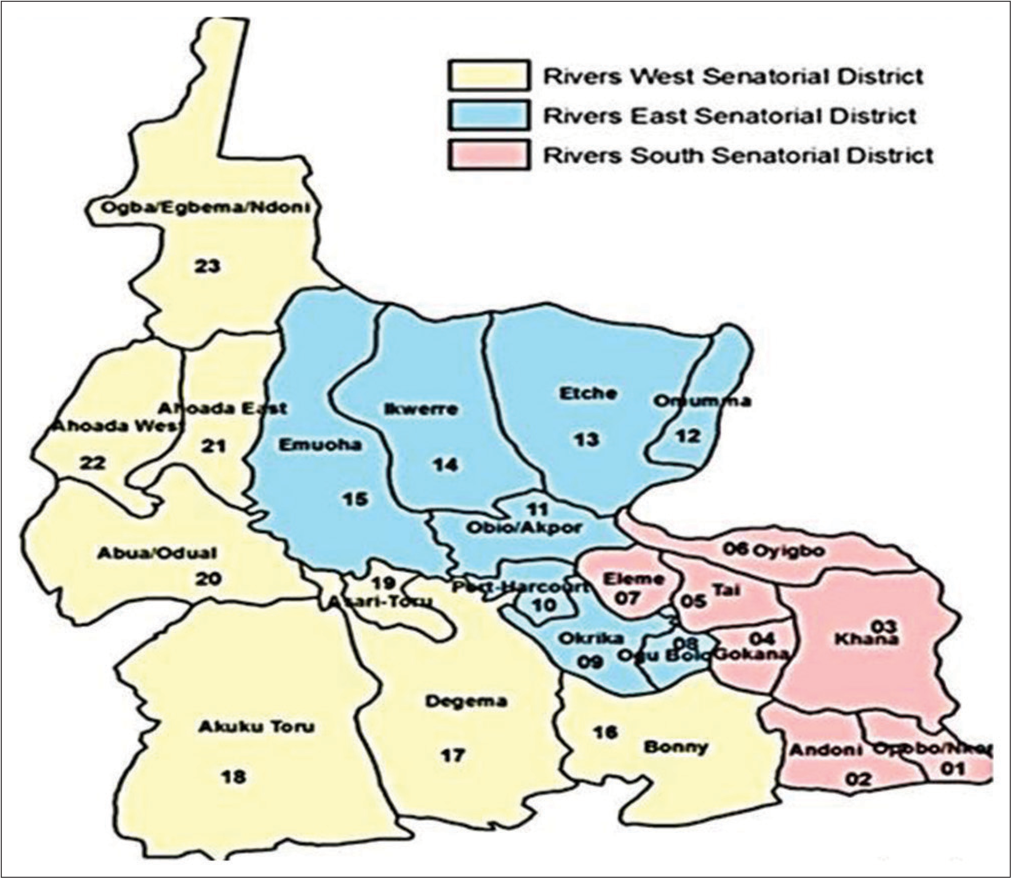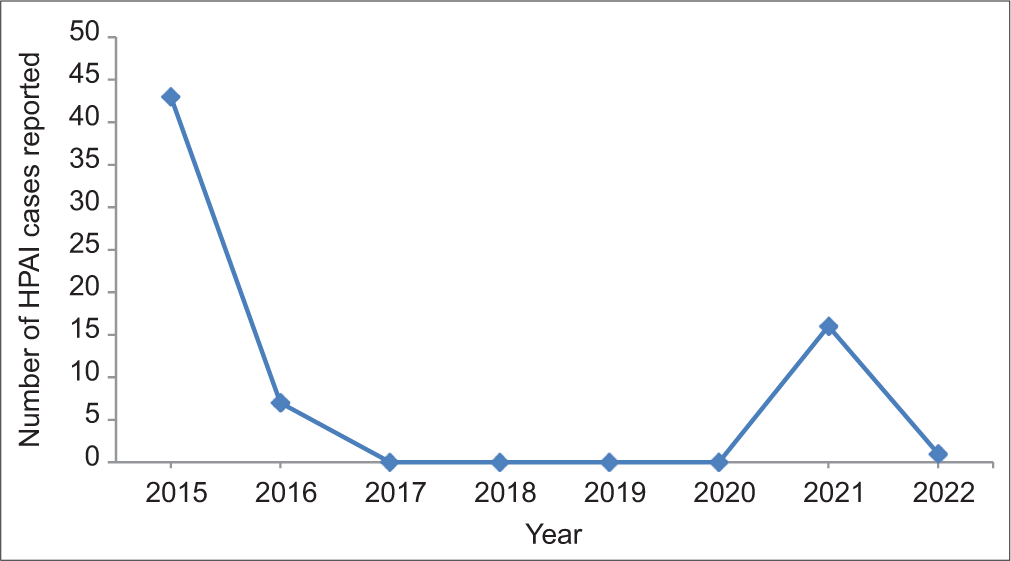Translate this page into:
Retrospective Study of Highly Pathogenic Avian Influenza Outbreaks from 2015 to 2022 in Rivers State, Nigeria

-
Received: ,
Accepted: ,
How to cite this article: Ogolo FO, Nwanga E, Orakpoghenor O, Markus TP, Bello AL. Retrospective Study of Highly Pathogenic Avian Influenza Outbreaks from 2015 to 2022 in Rivers State, Nigeria. Res Vet Sci Med. 2023;3:2. doi:10.25259/RVSM_6_2023
Abstract
Objectives:
Highly pathogenic avian influenza (HPAI) constitutes one of the major constraints in the development of the poultry industry, and sporadic outbreaks are still being reported in Nigeria. It is zoonotic, with several reports of human cases. The aim of this study was to determine the trend and distribution of HPAI outbreaks from 2015 to 2022 in Rivers State, Nigeria. Eight-year retrospective study was conducted by reviewing the Avian influenza (AI) line list and case reports of confirmed outbreaks of HPAI in Rivers State from the AI desk office.
Material and Methods:
Data were cleaned, analyzed using descriptive statistics, and presented using tables and figures as appropriate.
Results:
The outcomes showed that a total of 67 HPAI cases were reported in Rivers State from 2015 to 2022, with the highest (64.2%) reported in 2015 and lowest (1.5%) in 2022. Layers were majorly affected. The HPAI cases were reported across 6 Local Government Areas (LGAs), with the highest (71.6% cases) reported in Obio-Akpor and the lowest (1.5%) in Oyigbo and Ogba-Egbema-Ndoni LGAs. Based on the distribution according to LGA and year, HPAI cases were reported in 5 LGAs (Port Harcourt, Obio-Akpor, Ikwerre, Oyigbo and Ogba-Egbema-Ndoni) in 2015, 2 LGAs (Obio-Akpor and Ikwerre) in 2016, 4 LGAs (Port Harcourt, Obio-Akpor, Ikwerre and Okrika) in 2021, and 1 LGA (Obio-Akpor) in 2022.
Conclusion:
The 2015 – 2022 outbreaks of HPAI in Rivers State were reported in six out of the 23 LGAs across Rivers State. Obio-Akpor LGA accounted for the highest-burden of HPAI in the State. There was no report of HPAI from 2017 to 2022 across the State. Intensive surveillance for AI and public awareness on prevention and control across Rivers State is, therefore, recommended with support and motivation from the government.
Keywords
Highly pathogenic avian influenza
Outbreak
Poultry
Rivers state
Surveillance
INTRODUCTION
Avian influenza (AI) is a highly contagious viral disease caused by influenza A viruses (IAV) and affects several species of domestic and wild birds.[1] Avian influenza viruses (AIVs) belong to the genus of influenza A, which is most spread among other influenza viruses, with members infecting avian and mammalian species.[2,3] The AIVs are IAVs with surface proteins of the 16 hemagglutinin (H1–16) and nine neuraminidase (N1–9) subtypes.[4,5] AIVs are classified into 2 strains, namely, low pathogenic avian influenza (LPAI) and highly pathogenic avian influenza (HPAI) strains.[6] The LPAI strain constitutes a natural enteric infection of waterfowl and typically causes mild or no clinical signs.[7] The HPAI strain, on the other hand, causes severe clinical signs and potentially high mortality rates in poultry.[8]
Wild birds, particularly migratory waterfowl, are considered the natural reservoir for AIVs, with a large viral genetic pool.[9] AIVs are shed in the feces and respiratory secretions, and modes of transmission include direct contact with secretions from infected birds through feces or contaminated feed and water.[5] Other means of spread include through fomites and farm equipment due to the resistant nature of AIVs and their ability to survive for prolonged periods under low environmental temperatures.[1] Factors documented to contribute to the spread of AI include globalization and international trade, poultry farming and trading activities, wild birds and migratory routes, agricultural activities, environmental conditions, and land cover.[1,10]
Globally, there has been a constant increase in poultry production, especially in developing nations where 75% of the expansion is taking place.[11] HPAI has caused serious global economic problems, with the poultry industry being the most devastated and incurring major losses.[12] In Nigeria, HPAI constitutes one of the major constraints in the development of the poultry industry, thereby causing huge economic losses ranging from degradation of birds’ value from mortality and culling to job losses and management costs.[12,13] In 2006, the first outbreak of the HPAI H5N1 strain was reported in a commercial poultry farm in Kaduna State, North-West Nigeria.[14,15]
AI is zoonotic, with several reports of human cases.[16] Despite suggested control measures, a sporadic outbreak of AI is still being reported in Nigeria. There is a paucity of data on HPAI outbreaks in Rivers State, Nigeria. Furthermore, there is no documented report on the trend and distribution of HPAI from 2015 to 2022 in Rivers State, Nigeria. Therefore, in this study, the trend and distribution of HPAI outbreaks from 2015 to 2022 in Rivers State, Nigeria was determined.
MATERIAL AND METHODS
Study area
This study was conducted in Rivers State, Nigeria. Rivers State is one of the 36 States of Nigeria, located within latitude 4°18’58.294”N - 5°43’51.652”N and longitude 6°24’7.883”E - 7°35’58.68”E in the south-southern part of Nigeria. Rivers State has 23 Local Government Areas (LGAs). From the 2006 National Population Commission figures, the state has a population of 5,522,575. Port Harcourt, the largest city in the state, is the state capital and remains the center of the oil industry in Nigeria. Rivers State occupies an area of about 10,363.98 km2, with more than one-third occupied by water.[17]
Data collection
Seven years of retrospective data and records of AI outbreaks were studied and collated from the River State AI desk office, Port Harcourt. The AI desk office has personnel who go all over the state for disease surveillance purposes, prevention, and control from time to time or to report or notify of any problem by the poultry farmers. The variables retrieved were the number of cases, species affected, and LGAs.
Data analysis
The data were cleaned and entered into a Microsoft Excel sheet. The distributions of HPAI cases based on the number of poultry affected and LGAs were presented in tables, while the trend of AI is presented in [Figure 1].

- Map of rivers state showing the Local Government Areas in the three senatorial districts results.
RESULTS
A total of 67 HPAI cases were reported in Rivers State from 2015 to 2022, with the highest (64.2%) reported in 2015, the lowest (1.5%) in 2022, and no case (0.0%) reported from 2017 to 2020 [Table 1 and Figure 2]. The total number of poultry affected was 200,558, with the highest in 2015 and the lowest in 2022, and layers were majorly affected [Table 1].

- Trend line showing the number of highly pathogenic avian influenza cases reported from 2015 to 2022 in Rivers State, Nigeria; HPAI: Highly pathogenic avian influenza.
| Year | No. of HPAI cases | Percentage | No. of poultry affected | Type of bird affected |
|---|---|---|---|---|
| 2015 | 43 | 64.2 | 103149 | Layers/broilers |
| 2016 | 7 | 10.4 | 18619 | Layers/broilers |
| 2017 | 0 | 0.0 | 0 | − |
| 2018 | 0 | 0.0 | 0 | − |
| 2019 | 0 | 0.0 | 0 | − |
| 2020 | 0 | 0.0 | 0 | − |
| 2021 | 16 | 23.9 | 75,540 | Layers |
| 2022 | 1 | 1.5 | 1450 | Layers |
| Total | 67 | 100.0 | 198,758 |
HPAI: Highly pathogenic avian influenza
The 67 cases of HPAI reported from 2015 to 2022 were reported across 6 LGAs, with the highest (71.6% cases) reported in Obio-Akpor and the lowest (1.5%) in Oyigbo and Ogba-Egbema-Ndoni LGAs [Table 2]. Based on the distribution by year, HPAI cases were reported in 5 LGAs (Port Harcourt, Obio-Akpor, Ikwerre, Oyigbo, and Ogba-Egbema-Ndoni) in 2015, 2 LGAs (Obio-Akpor and Ikwerre) in 2016, 4 LGAs ((Port Harcourt, Obio-Akpor, Ikwerre, and Okrika) in 2021, and 1 LGA (Obio-Akpor) in 2022 [Table 2].
| LGA | 2015 | 2016 | 2017 | 2018 | 2019 | 2020 | 2021 | 2022 | Total | % |
|---|---|---|---|---|---|---|---|---|---|---|
| Port Harcourt | 4 | 0 | 0 | 0 | 0 | 0 | 3 | 0 | 7 | 10.4 |
| Obio-Akpor | 34 | 2 | 0 | 0 | 0 | 0 | 10 | 1 | 48 | 71.6 |
| Ikwerre | 3 | 5 | 0 | 0 | 0 | 0 | 1 | 0 | 9 | 13.4 |
| Oyigbo | 1 | 0 | 0 | 0 | 0 | 0 | 0 | 0 | 1 | 1.5 |
| Ogba-Egbema-Ndoni | 1 | 0 | 0 | 0 | 0 | 0 | 0 | 0 | 1 | 1.5 |
| Okrika | 0 | 0 | 0 | 0 | 0 | 0 | 2 | 0 | 2 | 3.0 |
| Total | 43 | 7 | 0 | 0 | 0 | 0 | 16 | 1 | 67 | 100.0 |
LGA: Local government areas.
DISCUSSION
The study of AI from 2015 to 2017 in Nigeria revealed that hotspots for AI outbreaks were clustered in six states and five geopolitical zones: North-west (Kano), North-central (Plateau, Abuja), Northeast (Bauchi), South-west (Oyo), and South-south (Rivers) State.[18] The findings from the present study revealed that a total of 67 cases of HPAI outbreaks were reported in Rivers State from 2015 to 2022. This number is lower than that reported in Kano State (287) but higher than those reported in Kaduna (39), Lagos (30), Delta (11), Edo (11), Bayelsa (2), and Benue (2) from 2015 to 2017.[18]
The distribution of these reports shows 43 cases in 2015, 7 cases in 2016, 16 cases in 2021, and 1 case in 2022, with no case between 2017 and 2020. A previous study in Rivers State from 2015 to 2017 reported 50 cases , with 43 cases in 2015, 7 cases in 2016, and no case in 2017. The total number of poultry affected was 198,758, with the highest in 2015, and this coincided with the highest number of cases. This high number of cases in 2015 was due to the resurgence of the disease in Nigeria, as several states reported HPAI during this time.[18,19] Furthermore, it might be associated with increased surveillance and reporting due to the resurgence. The increase in awareness of poultry stakeholders on AI following the press conference by the Minister for Agriculture in 2015[20] might be another reason for this high number of cases.
The AI cases reported in 2015 were followed by a decrease in HPAI cases in 2016 and an absence of cases from 2017 to 2020. The decrease in cases in 2016 might be due to AI control linked to the distribution of AI control materials by the Federal Department of Veterinary Services. This was targeted at strengthening containment while maintaining the capacity building of epidemiology officers toward containment.[20] The absence of cases from 2017 to 2020 might be due to a lack of surveillance associated with the inadequate number of veterinarians within the public service of the state. The lack of reporting by farmers, probably resulting from a lack of cooperation by the government in terms of compensation, might be another reason for the no cases reported from 2017 to 2020 in Rivers State.
There was an increase in the number of cases reported in 2021, and this also coincided with several reports across Nigeria. This increase might be due to enhanced surveillance within the state resulting from the mobilization of Regional Disease Surveillance Systems Enhancement Project Veterinary Officers to the state by the Federal Ministry of Agriculture and Rural Development. The increased awareness on AI during this period , both at the federal and state levels might be another reason for this observation.
The distribution of AI cases based on LGA in this study showed that there were more cases reported in Obio-Akpor LGA followed by Ikwerre and Port Harcourt LGAs. This suggests there is more AI surveillance activities going on in these LGAs and/or these LGAs are covered by the inadequate number of available surveillance officers. Reporting by farmers in these LGAs might be another possible reason and might be influenced by their close proximity to the capital.
Although the south-western states of Nigeria were often considered as the major poultry hub, the Nigeria poultry business is such that there is a bi-directional movement of day-old chicks from Southern to Northern Nigeria, while poultry raw material (maize, wheat, and jute bags) are transported to the Southern states of Nigeria from the North.[21] There is also movement of day-old chicks and feed from other areas to Rivers State; thus, these poultry trades may be epidemiologically linked to the outbreaks in the state. Other factors that might be responsible for outbreaks in the state include ineffective quarantine services, poor biosecurity measures by farming units during production, and transport of poultry and its products.[18] In addition, the outbreak and spread of AI in the state might be associated with free-living wild or migratory birds.[22]
Limitation
There was inadequate data due to the inadequate number of veterinary officers within the state’s public service. Most of the data available were limited to LGAs close to the state’s capital.
CONCLUSION
A total of 67 confirmed HPAI cases were reported from 2015 to 2022 in Rivers State, Nigeria. These outbreaks of HPAI in Rivers State were reported in six out of the 23 LGAs across Rivers State. Obio-Akpor LGA accounted for the highest-burden of HPAI in the State. There was no report of HPAI from 2017 to 2020 across the state.
Recommendations
There should be increased awareness on AI, and farmers should be encouraged to implement strict biosecurity measures so as to keep the poultry environment safe from AI and other infectious poultry diseases. There is a need for support and motivation from the government to enhance surveillance and encourage prevention and control of AI in the state.
Acknowledgments
These organizations and individuals have made a significant contribution to the preparation and production of this publication:
United States Agency for International Development, Food and Agriculture Organization of the United Nations.
The Directorate of Veterinary Services, Ministry of Agriculture, Rivers State, Nigeria.
Regional Disease Surveillance Systems Enhancement (REDISSE) Project Veterinary Officers.
Ethical approval
The research/study complied with the Helsinki Declaration of 1964.
Declaration of patient consent
Patient’s consent not required as there are no patients in this study.
Conflicts of interest
There are no conflicts of interest.
Use of artificial intelligence (AI)-assisted technology for manuscript preparation
The authors confirm that there was no use of artificial intelligence (AI)-assisted technology for assisting in the writing or editing of the manuscript and no images were manipulated using AI.
Financial support and sponsorship
This study is part of ISAVET’s internship field activities and was partly funded by the United States Agency for International Development (USAID).
References
- A Framework for the Risk Prediction of Avian Influenza Occurrence: An Indonesian Case Study. PLoS One. 2021;16:e0245116.
- [CrossRef] [PubMed] [Google Scholar]
- Avian Influenza Viruses in Humans: Lessons from Past Outbreaks. Br Med Bull. 2019;132:81-95.
- [CrossRef] [PubMed] [Google Scholar]
- Avian Influenza Human Infections at the Human-Animal Interface. J Infect Dis. 2020;222:528-37.
- [CrossRef] [PubMed] [Google Scholar]
- Evolution and Ecology of Influenza A Viruses. Microbiol Rev. 1992;56:152-79.
- [CrossRef] [PubMed] [Google Scholar]
- Genetic Characteristics and Pathogenesis of H5 Low Pathogenic Avian Influenza Viruses from Wild Birds and Domestic Ducks in South Korea. Sci Rep. 2020;10:12151.
- [CrossRef] [PubMed] [Google Scholar]
- Low Pathogenic Avian Influenza and Co-infecting Pathogens: A Review of Experimental Infections in Avian Models. Avian Dis. 2017;61:3-15.
- [CrossRef] [PubMed] [Google Scholar]
- Highly Pathogenic Avian Influenza Virus (H5N8) Clade 2.3.4.4 Infection in Migratory Birds, Egypt. Emerg Infect Dis. 2017;23:1048-51.
- [CrossRef] [PubMed] [Google Scholar]
- Diseases of Poultry In: Boulianne M, Logue CM, McDougald LR, Nair V, Suarez DL, eds. Ch. 6. Hoboken: Wiley; 2020. p. :210-56.
- [CrossRef] [Google Scholar]
- Influenza A H5N1 and H7N9 in China: A Spatial Risk Analysis. PLoS One. 2017;12:e0174980.
- [CrossRef] [PubMed] [Google Scholar]
- The State of Food and Agriculture. 2013. Available from: https://www.fao.org/docrep/018/i3300e/i3300e.pdf [Last accessed on 2023 Oct 28]
- [Google Scholar]
- The Economic Impact of Some Important Viral Diseases Affecting the Poultry Industry in Abuja, Nigeria. Sokoto J Vet Sci. 2017;15:7-17.
- [CrossRef] [Google Scholar]
- Impact of Avian Influenza Outbreaks on Stakeholders in the Poultry Industry in Jos, Plateau State, Nigeria. Int J Anim Vet Adv. 2015;7:13-7.
- [CrossRef] [Google Scholar]
- Confirmation of H5N1 Avian Influenza in Africa. Vet Rec. 2006;158:309-10.
- [CrossRef] [PubMed] [Google Scholar]
- Field and Laboratory Findings of the First Incursion of the Asian H5N1 Highly Pathogenic Avian Influenza Virus in Africa. Avian Pathol. 2007;36:115-7.
- [CrossRef] [PubMed] [Google Scholar]
- Confirmed Human Cases of Avian Influenza A (H5N1) Geneva: World Health Organization; 2007.
- [Google Scholar]
- Rivers State Ministry of Health. In: Rivers State Government Strategic Health Development Plan 2010-2015. Nigeria: Rivers State Ministry of Health; 2010. p. :10.
- [Google Scholar]
- Descriptive Epidemiology of the Outbreak of Avian Influenza in Nigeria: A Retrospective Review, 2015-2017. PAMJ One Health. 2021;6:1-13.
- [CrossRef] [Google Scholar]
- Retrospective Study of Avian Influenza Outbreak from 2015-2017; Resurgences in Plateau State Nigeria. Acta Sci Microbiol. 2020;3:70-2.
- [Google Scholar]
- Retrospective Study of the Burden of Avian Influenza in Kano State, Nigeria: A Secondary Data Analysis 2015-2017. East Afr J Agric Biotechnol. 2019;4:1-12.
- [CrossRef] [Google Scholar]
- Assessment of the Nigerian Poultry Market Chain to Improve Biosecurity Rome: FAO; 2008. p. :1-65.
- [Google Scholar]
- The Role of Wild Birds in the Spread of HPAI H5N1. Avian Dis. 2007;51:440-7.
- [CrossRef] [PubMed] [Google Scholar]






